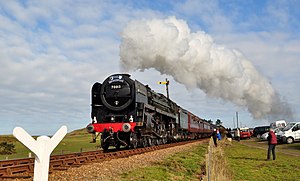BR Standard Class 7

|
|||||||||||||||||||||||||||||||||||||||||||||||||||||||
|
|||||||||||||||||||||||||||||||||||||||||||||||||||||||
|
|||||||||||||||||||||||||||||||||||||||||||||||||||||||
|
|||||||||||||||||||||||||||||||||||||||||||||||||||||||
|
|||||||||||||||||||||||||||||||||||||||||||||||||||||||
| Type and origin | |
|---|---|
| Power type | Steam |
| Designer | Robert Riddles |
| Builder | BR Crewe Works |
| Build date | January 1951 – September 1954 |
| Total produced | 55 |
| Specifications | |
|---|---|
| Configuration | 4-6-2 |
| UIC class | 2′C1′h2 |
| Gauge | 4 ft 8 1⁄2 in (1,435 mm) standard gauge |
| Leading dia. | 3 ft 0 in (0.914 m) |
| Driver dia. | 6 ft 2 in (1.880 m) |
| Trailing dia. | 3 ft 3 1⁄2 in (1.003 m) |
| Length | 68 ft 9 in (20.96 m) |
| Width | 8 ft 8 3⁄4 in (2.66 m) |
| Height | 13 ft 0 1⁄2 in (3.98 m) |
| Axle load | 20.50 long tons (20.83 t; 22.96 short tons) |
| Adhesive weight | 61.50 long tons (62.49 t; 68.88 short tons) |
| Loco weight | 94.00 long tons (95.51 t; 105.28 short tons) |
| Tender weight | BR1: 49.15 long tons (49.94 t; 55.05 short tons) BR1A: 52.50 long tons (53.34 t; 58.80 short tons) BR1D: 54.50 long tons (55.37 t; 61.04 short tons) |
| Tender type | BR1 (40), BR1A (5), or BR1D (10) |
| Fuel type | Coal |
| Fuel capacity | BR1/BR1A: 7.0 long tons (7.1 t; 7.8 short tons) BR1D: 9.0 long tons (9.1 t; 10.1 short tons) |
| Water cap | BR1 4,250 imp gal (19,300 l; 5,100 US gal) BR1A: 5,000 imp gal (23,000 l; 6,000 US gal) BR1D: 4,750 imp gal (21,600 l; 5,700 US gal) |
| Firebox: • Firegrate area |
42 sq ft (3.9 m2) |
| Boiler | BR1 |
| Boiler pressure | 250 psi (1.72 MPa) |
| Heating surface: • Tubes and flues |
2,264 sq ft (210.3 m2) |
| • Firebox | 210 sq ft (20 m2) |
| Superheater: |
|
| • Heating area | 718 sq ft (66.7 m2) |
| Cylinders | Two, outside |
| Cylinder size | 20 in × 28 in (508 mm × 711 mm) |
| Performance figures | |
|---|---|
| Tractive effort | 32,150 lbf (143.0 kN) |
| Factor of adh. | 4.23 |
| Career | |
|---|---|
| Operators | British Railways |
| Power class | 7MT |
| Numbers | 70000–70054 |
| Axle load class |
Route availability 8 BR (WR): Red |
| Locale | Eastern Region, London Midland Region, Scottish Region, Southern Region, Western Region |
| Withdrawn | June 1965 – August 1968 |
| Disposition | Two preserved, remainder scrapped |
The BR Standard Class 7, otherwise known as the Britannia Class, is a class of 4-6-2 Pacific steam locomotive designed by Robert Riddles for use by British Railways for mixed traffic duties. Fifty-five were constructed between 1951 and 1954. The design was a result of the 1948 locomotive exchanges undertaken in advance of further locomotive classes being constructed. Three batches were constructed at Crewe Works, before the publication of the 1955 Modernisation Plan.
The Britannia Class was based on several previous LMS locomotive designs,and also significantly influenced by the Bulleid SR Pacifics, notably in the boiler and rear truck design, incorporating the best practices in locomotive technology as regards labour-saving and lowering maintenance costs; various weight-saving measures also increased the route availability of a Pacific-type locomotive on the British Railways network. The Britannias received a positive reception from their crews, with those regularly operating the locomotives giving them favourable reports as regards performance. However, trials in some areas of the British Railway network returned negative feedback, primarily due to indifferent operation of the locomotive, with its effects on adhering to timetables.
The Britannias took their names from great Britons, former Star Class locomotives, and Scottish firths. The class remained in service until the last was withdrawn in 1968. Two survived into preservation, the first-of-class, number 70000 Britannia, and 70013 Oliver Cromwell. Number 70000 has hauled mainline excursions and 70013, after a period of display following limited steaming, returned to mainline steam in 2008 for the first time since leaving British Railways ownership. 70000 was returned to the main line in 2011.
Locomotive exchanges were commissioned by the fledgling British Railways (BR) during 1948, to test the best and worst aspects of locomotive design within the Big Four railway companies that had existed before nationalisation. The research gained from operating the best designs of the GWR, LMS, LNER and Southern railways on different areas of the British Railways network paved the way for several new classes of standardised locomotives to be constructed. These new locomotive designs were intended to replace some of the ageing designs inherited by British Railways.
...
Wikipedia
